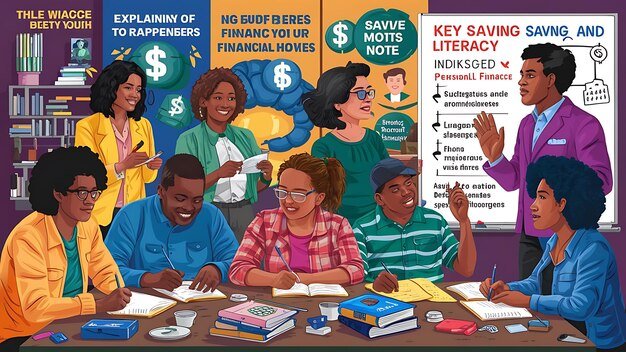Credit Cards and Financial Literacy: Empowering Minority Communities in the US

Credit cards can play a vital role in building financial literacy within minority communities in the US by helping individuals understand credit scores, manage debt responsibly, and access financial tools for long-term stability.
Are you looking to understand how credit cards can be powerful tools for building financial literacy, particularly in minority communities across the US? This article explores how responsible credit card use can empower individuals to achieve financial stability and navigate the complexities of the financial world.
Understanding the Financial Literacy Gap in Minority Communities
Financial literacy is a critical skill that enables individuals to make informed decisions about their money, investments, and overall financial well-being. However, significant disparities exist in financial literacy levels across different communities in the United States.
Minority communities often face unique challenges that contribute to lower levels of financial literacy, including limited access to financial education, historical economic disadvantages, and systemic barriers to wealth accumulation.
The Impact of Limited Financial Education
One of the primary reasons for the financial literacy gap is the lack of access to quality financial education. Many schools in underserved communities do not offer comprehensive financial literacy programs, leaving students unprepared to manage their finances effectively.
Additionally, language barriers and cultural differences can further complicate access to financial information for some minority groups, making it difficult for them to understand complex financial concepts.

Socioeconomic Factors and Financial Literacy
Socioeconomic factors also play a significant role in financial literacy. Lower-income households often have less disposable income to invest in financial education resources or seek professional advice.
- Historical Disadvantages: Past discriminatory practices have created lasting financial barriers for minority communities.
- Access to Resources: Unequal access to banking and financial services limits opportunities for financial growth.
- Economic Instability: Higher unemployment rates and lower wages contribute to financial insecurity.
These factors create a cycle of financial vulnerability that is difficult to break without targeted interventions and increased access to financial education.
Understanding the financial literacy gap is the first step toward addressing it. By recognizing the unique challenges faced by minority communities, we can develop tailored strategies to promote financial education and empower individuals to achieve financial stability.
The Role of Credit Cards in Financial Education
Credit cards are often viewed with caution due to the potential for debt accumulation and financial mismanagement. However, when used responsibly, credit cards can be valuable tools for building financial literacy and establishing a positive credit history.
For minority communities that often lack access to traditional financial resources, credit cards can provide a gateway to understanding credit scores, managing debt, and accessing financial opportunities.
Understanding Credit Scores
One of the most significant benefits of using credit cards is the opportunity to build a credit score. A credit score is a numerical representation of a person’s creditworthiness, based on their payment history, credit utilization, and other factors.
A good credit score is essential for obtaining loans, mortgages, and other forms of credit at favorable interest rates. It can also impact employment opportunities, insurance premiums, and even rental applications.
Managing Debt Responsibly
Credit cards can teach individuals how to manage debt responsibly. By tracking spending, making timely payments, and keeping credit utilization low, individuals can learn valuable budgeting skills and avoid the pitfalls of excessive debt.
Responsible credit card use also involves understanding interest rates, fees, and other terms and conditions. This knowledge empowers individuals to make informed decisions and avoid costly mistakes.
Accessing Financial Opportunities
Credit cards can provide access to financial opportunities that would otherwise be unavailable. For example, a credit card can be used to make online purchases, rent a car, or book a hotel room.
- Building Credit History: Using a credit card responsibly establishes a positive payment history.
- Emergency Funds: Credit cards can serve as a safety net during unexpected financial emergencies.
- Rewards and Benefits: Many credit cards offer rewards, cashback, and other benefits that can enhance financial well-being.
These opportunities can be particularly valuable for minority communities that often face barriers to accessing traditional financial services.
Using credit cards responsibly can promote financial education and empower individuals to achieve their financial goals. By understanding the benefits and risks associated with credit cards, individuals can make informed decisions and build a strong financial foundation.
Strategies for Promoting Credit Card Literacy
Promoting credit card literacy within minority communities requires a multifaceted approach that addresses the unique challenges and barriers faced by these groups. This includes providing access to culturally relevant financial education and implementing targeted interventions to promote responsible credit card use.
By empowering individuals with the knowledge and skills they need to manage credit effectively, we can help them build a strong financial foundation and achieve their long-term financial goals.
Culturally Relevant Financial Education
Financial education programs should be tailored to the specific needs and cultural contexts of minority communities. This includes addressing language barriers, incorporating culturally relevant examples, and partnering with trusted community organizations.
Culturally relevant financial education can help build trust and rapport with community members, making them more receptive to learning about credit card management and other financial topics.
Targeted Interventions
Targeted interventions can help individuals who are at risk of credit card debt or financial mismanagement. This includes providing personalized financial coaching, offering debt counseling services, and promoting access to affordable credit options.
These interventions can help individuals develop the skills they need to manage their finances effectively and avoid the pitfalls of excessive debt.

Community Partnerships
Community partnerships can play a crucial role in promoting credit card literacy. By partnering with local organizations, schools, and businesses, we can reach a wider audience and provide access to financial education resources in convenient and accessible locations.
- Workshops and Seminars: Offering educational sessions on credit card basics and responsible usage.
- Mentorship Programs: Pairing individuals with financial mentors who can provide guidance and support.
- Online Resources: Creating accessible online resources and tools to help individuals manage their credit cards effectively.
These partnerships can help create a supportive environment that encourages financial education and empowers individuals to take control of their financial lives.
Promoting credit card literacy requires a comprehensive approach that addresses the unique needs and challenges faced by minority communities. By providing access to culturally relevant financial education, implementing targeted interventions, and fostering community partnerships, we can empower individuals to manage credit responsibly and achieve their financial goals.
Success Stories: Credit Cards as Tools for Empowerment
While credit cards can be a source of financial stress for some, there are numerous success stories of individuals within minority communities who have used credit cards as tools for empowerment. These stories highlight the potential for credit cards to promote financial literacy and create opportunities for economic advancement.
By learning from these examples, we can inspire others to take control of their finances and use credit cards responsibly to achieve their goals.
Building Credit and Securing a Home
One common success story involves individuals who have used credit cards to build a positive credit history and secure a mortgage. By making timely payments and keeping their credit utilization low, these individuals were able to qualify for a home loan and achieve their dream of homeownership.
This is particularly significant for minority communities, who often face barriers to accessing affordable housing. A good credit score can make the difference between renting and owning a home, allowing individuals to build equity and wealth over time.
Funding Education and Entrepreneurship
Credit cards can also be used to fund education and entrepreneurship. Many students use credit cards to cover tuition expenses or purchase textbooks, while aspiring entrepreneurs use them to start a business or fund marketing campaigns.
While using credit cards for these purposes carries some risk, it can also provide access to opportunities that would otherwise be unavailable. By managing their credit card debt responsibly, individuals can invest in their future and achieve their educational and professional goals.
Overcoming Financial Emergencies
Credit cards can serve as a safety net during unexpected financial emergencies. Whether it’s a medical bill, a car repair, or a job loss, a credit card can provide access to funds when other options are limited.
- Emergency Fund: A credit card can be used to cover unexpected expenses, providing peace of mind.
- Building a Safety Net: Responsible credit card use can help create a financial cushion for emergencies.
- Access to Resources: Credit cards can provide access to resources and services that can help individuals navigate financial challenges.
However, it’s important to use credit cards cautiously during emergencies and avoid accumulating excessive debt. By developing a budget and seeking financial advice, individuals can manage their finances effectively and avoid long-term financial hardship.
These success stories demonstrate the potential for credit cards to be powerful tools for empowerment within minority communities. By using credit cards responsibly, individuals can build credit, access opportunities, and overcome financial challenges.
The Future of Credit Card Literacy in the US
The future of credit card literacy in the US depends on a concerted effort to address the underlying issues that contribute to financial disparities within minority communities. This includes expanding access to financial education, promoting responsible lending practices, and fostering a culture of financial empowerment.
By working together, we can create a financial system that is fair, equitable, and accessible to all.
Expanding Access to Financial Education
One of the most important steps toward improving credit card literacy is to expand access to financial education programs. This includes offering financial literacy classes in schools, community centers, and workplaces.
These programs should cover a wide range of topics, including budgeting, credit card management, debt reduction, and investment strategies. By providing individuals with the knowledge and skills they need to manage their finances effectively, we can help them avoid the pitfalls of credit card debt and achieve their financial goals.
Promoting Responsible Lending Practices
Responsible lending practices are also essential for promoting credit card literacy. This includes ensuring that credit cards are marketed responsibly, that interest rates and fees are transparent, and that borrowers are not overburdened with excessive debt.
By holding lenders accountable for their practices, we can protect vulnerable consumers from predatory lending and promote a more equitable financial system.
Fostering a Culture of Financial Empowerment
Ultimately, the future of credit card literacy depends on fostering a culture of financial empowerment. This includes encouraging open conversations about money, promoting financial planning, and celebrating financial success stories.
- Community Support: Creating supportive communities where individuals can share financial advice and experiences.
- Financial Role Models: Highlighting success stories to inspire others to take control of their finances.
- Accessible Resources: Ensuring that financial resources are readily available and easy to understand.
By creating a culture of financial empowerment, we can help individuals take control of their financial lives and achieve their dreams.
The future of credit card literacy in the US is bright, but it requires a collective effort to address the underlying issues that contribute to financial disparities within minority communities. By expanding access to financial education, promoting responsible lending practices, and fostering a culture of financial empowerment, we can create a financial system that is fair, equitable, and accessible to all.
| Key Point | Brief Description |
|---|---|
| 💡 Building Credit | Using credit cards responsibly to establish a positive credit history. |
| 💰 Managing Debt | Understanding interest rates and making timely payments to avoid debt. |
| 📚 Financial Education | Accessing resources to improve financial literacy and decision-making. |
| 🤝 Community Support | Leveraging community partnerships to promote financial well-being. |
Frequently Asked Questions
▼
▼
▼
▼
▼
Conclusion
In conclusion, credit cards can be powerful tools for building financial literacy within minority communities in the US. By understanding how to use credit cards responsibly, individuals can build credit, access financial opportunities, and achieve their long-term financial goals. It is vital to promote financial education and responsible lending practices to ensure that credit cards are used to empower individuals rather than burden them with debt.





